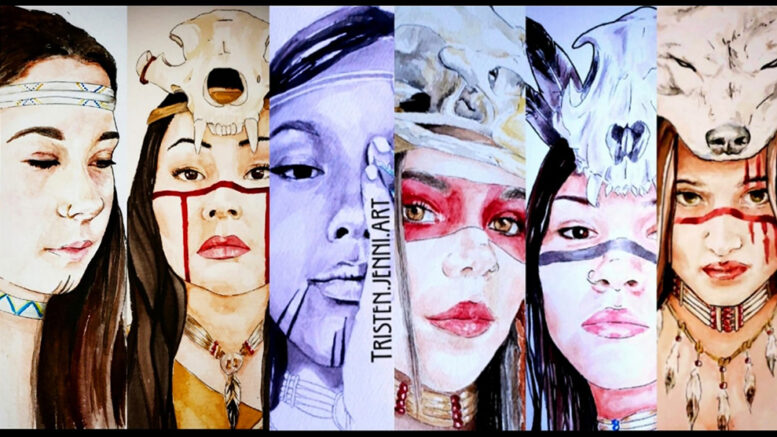By Chevi Rabbit, Local Journalism Initiative Reporter
(ANNews) – Tristen Jenni Sanderson is a gifted tattoo artist from James Smith, Saskatchewan, and calls Edmonton, Alberta home. Despite the challenges of growing up in a crowded and sometimes challenging environment, Tristen found her creativity in tattoo artistry.
“After my father, Gerald Sanderson passed away five years ago, I decided that I was going to focus on my artistic skills,” said Sanderson.
“I figured I shouldn’t care what others think, and I should do what I am naturally good at, so I started drawing every day, even on days I didn’t want to. I tried different mediums and styles, and then started using water colours, which I found out I love.”
After about a year, Sanderson took her work to a tattoo shop in Hinton, Alberta, “and they loved it. They were immediate,” she said, and they told her they would teach her how to tattoo.
Sanderson landed a job as one of the junior artists at a Tattoo Shop in Edmonton, but she told the owner that she just wanted to do Indigenous inspired artwork. “I just wanted to do what I was good at and it just took off from there.”
She has now honed her skills and she is using her talents to express herself and connect with others. And it’s through her work as a tattoo artist that Sanderson has become a role model and inspiration to others.
“As a tattoo artist, I learned to trust myself as an artist,” said Sanderson. “We are so gifted as Indigenous people with our artwork,” and as storytellers.
Sanderson comes from a large family – with five brothers and four sisters. Her experience of growing up with parents who struggled with past trauma from Canada’s Residential Schools and her family dynamics gave her a unique perspective on life and art.
She moved to Edmonton with her mother when she was three. “My mother left my father; she decided to try to make it in Edmonton,” said Sanderson. “My father was traditional, so it conflicted at times in the home, but he did his best.”
Edmonton was difficult, continued Sanderson. “We lived in the vehicle for a little while, and my mother tried to get her footing; she eventually became a social worker. Unfortunately, my mother struggled with addiction issues – both my mother and father were residential school survivors.”
Sanderson’s parents tried to work on their issues while she was growing up, but sometimes it didn’t go very well. The Sanderson home was crowded, she noted. “We lived in a two-bedroom apartment in Edmonton with my mother; about six of us lived there.”
“When you grow up in the city. It’s hard to love who you are sometimes because you are made fun of for being Indigenous,” added Sanderson. “We tried to make the best of certain situations.”
During these moments, Tristen would retreat into her art.
“I spent a lot of time drawing; I kept to myself, I had a lot of anxiety,” she said. “My anxiety would often show up in stomach pains, because that’s how anxiety often shows up in children, and eventually when they get older, they get migraines.”
Thanks to her father’s influence, Tristen’s upbringing was rich in traditional Indigenous culture and art. Her exposure to traditional art forms such as star blankets, beading, and drum making, as well as her experience with ceremonies and powwows, gave her a strong foundation.
This foundation, combined with her natural talent and passion for art, paved the way for her career as an Indigenous artist. Sanderson’s father recognized her talent and encouraged her to pursue her dreams, which gave her the confidence and motivation to become the successful artist she is today.
Her art reflects her deep connection to her Indigenous heritage and her commitment to preserving and sharing traditional art forms with the world. Through her work, she honours her family’s legacy and inspires others to embrace their cultural identities and artistic talents.
Sanderson encourages youth to try many art forms, mediums, and techniques. “I bead, I create art on canvas, with paint or pencil, or pastel, and I create tattoos,” she said.
“I do a lot of bead work. This might sound weird, but I had a dream that I was wearing a beaded choker, so I decided to make one. I posted one on social media, and it took off from there.”
Dreams play heavily into her paintings too. “I have dreams of them,” she says. “I will often wake up in the middle of the night and write them down or do a voice recording and then I create them.
“I did a painting series called a Warrior Women Collection. I created those to show women in all their different roles in the past; we weren’t all just gatherers or mothers. We were warriors as well, we were tribe leaders; we did pick medicine, and we were mothers and teachers, but we also had, non-gender specific roles.”
She ends the interview by saying, “The biggest lesson I learned was to listen to myself, my intuition. So if I can tell the youth, just be honest with yourself, and the Creator gifts these beautiful things to you. If you are open to them, and if you just really listen to them, they will naturally come to you.”
For more information, check out her website, www.tristenjenniart.com and Instagram: Tristen.Jenni.Art



Be the first to comment on "Tattoo artist Tristen Sanderson credits her late father for her success"